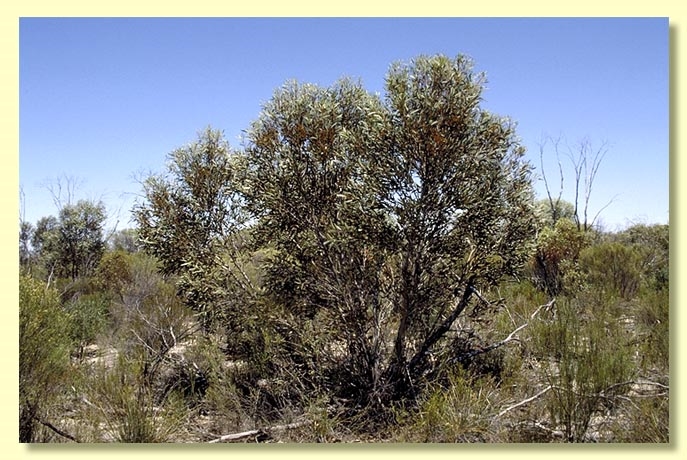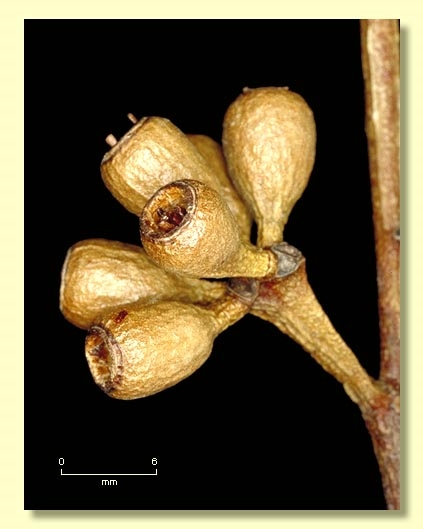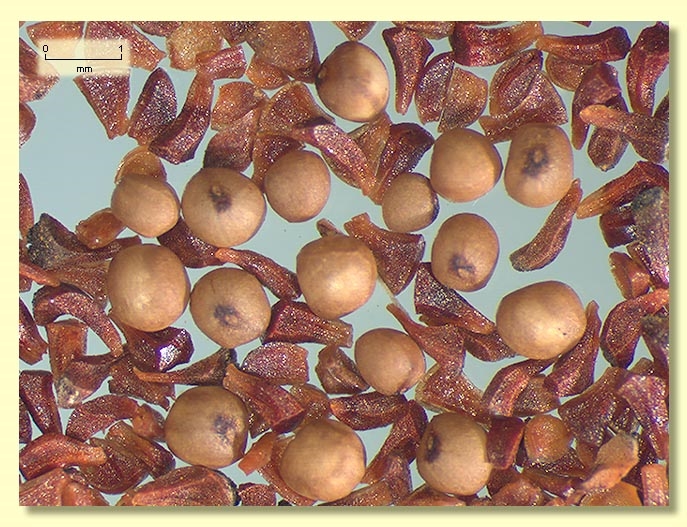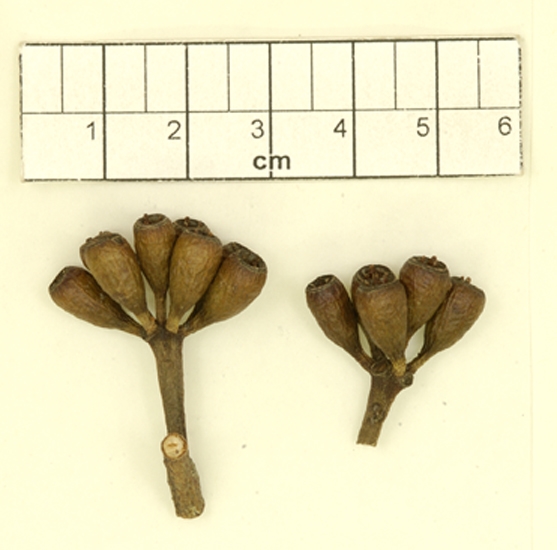Eucalyptus | Symphyomyrtus | Bisectae | Glandulosae | Levispermae | Phaenophylla
Euclid - Online edition
Eucalyptus luteola
Bark rough with partly shed greyish ribbons for basal 1 m of trunks, smooth above grey over pale coppery or yellowish-grey.
Branchlets with oil glands in the pith.
Juvenile growth (coppice or field seedlings to 50 cm): not seen.
Adult leaves alternate, petioles 0.7–1.7; blade linear to narrowly lanceolate, 6–9.5 cm long, 0.8–1.5 cm wide, base tapering to petiole, margin entire, apex pointed, concolorous, slightly glossy, green to olive green, side-veins at an acute or wider angle to midrib, reticulation moderate, intramarginal vein present, oil glands both island and intersectional.
Inflorescence axillary unbranched, peduncles widening apically, 1–1.7 cm long, buds ?9 to 13 per umbel, pedicellate (pedicels 0.3–0.5 cm long). Mature buds long-fusiform (1.8–1.9 cm long, 0.3–0.4 cm wide), scar present, operculum horn-shaped, three times the length of the hypanthium and scarcely narrower than it at the join, few outer stamens erect, most stamens variably deflexed, anthers oblong, versatile, dorsifixed, dehiscing by longitudinal slits, style long and straight, stigma tapered to rounded, locules 3, the placentae each with 4 vertical rows of ovules. Flowers lemon.
Fruit pedicellate (pedicels 0.1–0.3 cm long), cylindrical to barrel-shaped, 0.6–0.8 cm long, 0.5–0.7 cm wide, disc descending, valves 3, near rim level.
Seeds straw-coloured, 0.8–1.5 mm long, sub-spherical, surface smooth, hilum ventral/terminal.
Cultivated seedlings (measured at node 10): cotyledons Y-shaped (bisected); stems rounded or square in cross-section; leaves always petiolate, opposite for 2 or 3 nodes then alternate, lanceolate, 5–11.5 cm long, 1.2–2.5 cm wide, dull, grey-green becoming green and slightly glossy.
Flowering time unknown.
A mallee endemic to Western Australia, occurring on sand in "Hyden scrub" south to near Ravensthorpe. The bark is loose, rough on the lower trunk and the adult leaves slightly glossy, green to olive-green.
Eucalyptus luteola belongs to Eucalyptus subgenus Symphyomyrtus section Bisectae subsection Glandulosae because the cotyledons are bisected, buds have an operculum scar and the branchlets have oil glands in the pith. Within this subsection E. luteola is one of a group of species that form series Levispermae subseries Phaenophylla characterised by having smooth sub-spherical seed, a peduncle that widens apically, buds that are narrowly fusiform with some stamens erect and others variably deflexed, and glossy green leaves.
E. luteola is very close to E. phaenophylla subsp. interjacens, differing only in the less glossy adult leaves, semi-persistent scruffy bark on the lower trunks and buds slightly longer (to 2 cm long) but otherwise similar in shape. It differs from E. phaenophylla subsp. phaenophylla in having the operculum equal in width to the hypanthium at the join, not distinctly narrower. E. tumida differs in having fatter buds and slightly broader leaves. E. arachnaea differs in having tightly fibrous rough bark on the stems and buds with a recurved tip to the operculum and also in being narrower at the join of operculum and hypanthium.

















